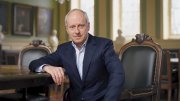By the usual metrics—large gifts, lots of them, for the identified aims—The Harvard Campaign and its school components announced to date are proceeding very well, with 57 percent of the overall goal realized just a few months after the public launch (see “Undergraduate Aid and Campaign Milestones”).
But in other respects, the campaign is unusual: seemingly quieter to date in its public phase than it was in the formal quiet period of fundraising that preceded the unveiling hoopla last autumn. The snazzy campaign website tells essentially nothing about specific campaign goals, or the level of giving needed to fund a scholarship, professorship, or other priority—and inquiries into such matters elicit the response that the figures are not public. This appears tactical: broad program descriptions maximize Harvard’s leverage and flexibility. With variable pricing, a dean can negotiate the size of the naming gift for a professorship above some floor, for instance. Nor is the University put in the awkward position of failing to meet any of its targets. Still, it seems odd, considering the information readily available from peer institutions.
More information might inspire more useful engagement. How much does Harvard plan to invest in athletics (plenty, apparently: the hockey-rink renovation, Stadium addition and reconfiguration, new basketball arena, and more) and the arts (a theater and dance concentration, for instance)? The libraries? Professorships in new fields (and which ones)? Global initiatives, and seemingly critical—but unspecified—research priorities such as energy and the environment? Donors and fundraisers may well know the answers. But the community at large, not so much.
It is clear that the campaign as a whole seeks to make a significant statement about engineering and applied sciences (targeted for perhaps a billion dollars, counting new faculty members, research and fellowship funds, innovations in pedagogy, and the facilities to be built in Allston). At a time of justifiable anxiety about higher-education finances, it is also designed to shore up the balance sheet by endowing as many existing professorships and as much aid as possible (to free unrestricted funds for future use).
But bringing the rest of the agenda into clearer focus, soon, would help educate the University community about the campaign’s other intellectual outcomes, illuminating the impact of the philanthropic largess now happily heading Harvard’s way.
~John S. Rosenberg, Editor






